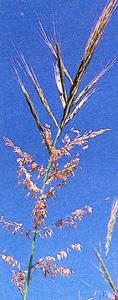
Canadian wild rice
€ Low price
Canadian wild rice is the fruit of the tall, flowering water grass "Ziziana aquatica" that is native to the shallow, clear lakes of North America.
The roots of the wild rice plant are embedded in the bottom of lakes or marshes and the green plant rises 1-3 metres above the water.
It is traditionally harvested at the time of the "wild rice moon" (September). The Native Americans harvest it by canoeing through the wild rice fields and knocking the ripe grains off the stalks and into the canoe with wooden sticks. The grains do not all ripen at the same time, and therefore the fields have to be worked several times for a sufficiently large quantity to be harvested. The canoe generally carries two people, of whom one, the "harvest man", is equipped with two long sticks (stockers).
One stockers bends the plinat stalks with the canicles over the side of the canoe, while the other is used to carefully knock the canicles so tha the ripe grains fall out and drop onto the floor of the canoe. When the stalks then whip back, grains fall off into the water - thereby sowing the seeds of next year's harvest.
The harvest grains are greenish-brown in colour and still contain a relative large amount of moisture. They are then dried and roasted over a wood fire. It is only during this process that they acquire their typical colour and the flavouring substances that give them their typical smoky, nutty taste.
The roots of the wild rice plant are embedded in the bottom of lakes or marshes and the green plant rises 1-3 metres above the water.
It is traditionally harvested at the time of the "wild rice moon" (September). The Native Americans harvest it by canoeing through the wild rice fields and knocking the ripe grains off the stalks and into the canoe with wooden sticks. The grains do not all ripen at the same time, and therefore the fields have to be worked several times for a sufficiently large quantity to be harvested. The canoe generally carries two people, of whom one, the "harvest man", is equipped with two long sticks (stockers).
One stockers bends the plinat stalks with the canicles over the side of the canoe, while the other is used to carefully knock the canicles so tha the ripe grains fall out and drop onto the floor of the canoe. When the stalks then whip back, grains fall off into the water - thereby sowing the seeds of next year's harvest.
The harvest grains are greenish-brown in colour and still contain a relative large amount of moisture. They are then dried and roasted over a wood fire. It is only during this process that they acquire their typical colour and the flavouring substances that give them their typical smoky, nutty taste.
Supplier


Company

Website
 Germany
Germany
Country
Product details
Place of processing
Canada
Origin of main ingredient

Origin of main ingredient

Packaging formats

Packaging

Composition


